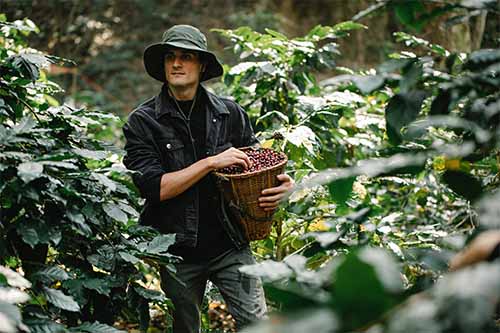There are many facets to coffee flavours, from the aspects of the farm that the beans are grown in, right down to the roast profile. One aspect that influences the flavour of the coffee is the altitude that the beans are grown in.
Some parts of the world have different signature flavours that come out of them. Ethiopia’s coffee for example usually packs a real fruity flavour. One reason for this is that their farms are at a high altitude. Colombia on the other hand usually farms at a lower altitude, and it’s beans have more of a chocolate taste.
Very High Altitude – Above 1500m
Many of the coffee beans grown at very high altitudes, ie above 1500m tend to have fruity flavours. When tasting a cup of coffee from a very high altitude in a cupping, you might find flavours like wine, berry, floral, spice or fruit. Coffee from Ethiopia tends to taste this way, grown at high altitudes, and because of it’s hot climate using a dry processing method, coffee beans out of Ethiopia tend to exhibit floral or fruity notes and are best enjoyed black.
High Altitude – 1200m – 1500m
Coffee grown at a high altitude, between approximately 1200 and 1500 meters, tend to have nutty or chocolate flavours. When tasting coffee from a high altitude, you might find notes like nut, chocolate, vanilla, or citrus. The majority of coffee we consume every day comes from this altitude. Places like Colombia are well known for coffee grown here, and because of it’s semi-dry processing method, coffee from this region tends to be sweet and chocolatey.
Medium Altitude – 900m – 1200m
Medium altitude coffees tend to avoid many of the citrus or fruit notes, and just appear smooth and sweet. A lot of coffee from Brazil tends to fit into this category. Much of the coffee we drink every day fits into this altitude, ranging from 900m to 1200m, it provides a very consistent flavour profile, for a very consistent flat white.
Low Altitude – 700m – 900m
Low altitude is where coffee growing really starts to get interesting. Coffee grown at this altitude tends to exhibit earthy, muddy, and almost vegetable type flavours. Some people really enjoy this kind of coffee, but it’s not for everyone. If it doesn’t sound appealing to you, you might want to aim for above 900m for your coffee beans. A lot of coffee from the low-lying plantations of Indonesia will exhibit these flavours.
Which altitude is best for me?
It’s good to try all the different altitudes before you make a decision, but don’t pin everything on altitude either. There are a lot of other aspects that change coffee beans’ flavour profiles, like processing method, climate, and roast profile. If you feel like you need some help getting matched with the perfect coffee for you, our quiz will find your flavour profile, and then match you with coffee beans whose attributes suit your tastes.
